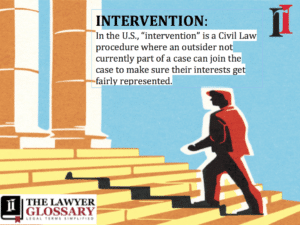Intervention
In the U.S., “intervention” is a Civil Law procedure where someone not currently part of a case can join the case to make sure their interests get fairly represented.
 There are two types of intervention:
There are two types of intervention:
Intervention of Right – When an outside party seeks to join a case via “intervention of right,” that person or party will have filed a motion with the courts presenting sufficient evidence that they have an interest in the money, the property or the issues involved, that they risk some form of injustice if not joined to the case, and that no one else already on the case can sufficiently represent their interests.
Permissive Intervention – When an outside party tries to join a case using the “permissive intervention” route, they may not have a direct financial interest in the case, but, they will be able to prove that there is a particular question of law or statute that needs clarification or interpretation by the judge.
Sometimes getting this question of what a law means and how it will be interpreted in the case will not happen unless another party intervenes and raises the issue themselves. A judge can deny the request or allow that party to be added to the case when that question of law is common enough to a significant group of people.
Related terms:
INTERVENOR: The outside person or party joining the case once permission is granted by the courts.
JOINDER: Intervention falls into the larger category of a legal procedure known as a joinder, the general process of adding plaintiffs, defendants or new claims to a case.
MOTION: A request to the judge to make a decision on a particular issue
FILE: To submit a document or similar item to the courts for consideration and/or addition to a case.
1-minute video defining “intervention”:
What Does Intervention Mean? Let’s Break It Down In Layman’s Terms:
There are a number of reasons you might want to be added to an existing case. In a personal injury case, for example, a car crash caused by a negligent driver might have affected not just the driver of another vehicle, but maybe a passenger or involved pedestrian who discovered injuries a few weeks after the collision. If they are not already listed as a party in the case, they could have a direct interest in being added, since they may have unique issues and perspectives needing fair representation.
You might hear “intervention” used like this, here’s what it means:
“Did you file the motion for intervention of right on behalf of our new client?”
Translation:
Our injured client really needs to be added to this case. Did you, the paralegal or attorney or assistant, go to the court clerk’s office and submit our request to the judge so that our injured client can be officially added to the case upon the judge’s approval?
“The judge denied our permissive intervention due to subject-matter jurisdiction.”
Translation:
We made the request to get added to this case in order to raise the issue of a few different bankruptcy laws which need interpretation from the judge. But, we got denied because those issues need to be handled specifically by a bankruptcy court and are not relevant enough to this case.
Recently added glossary terms:









